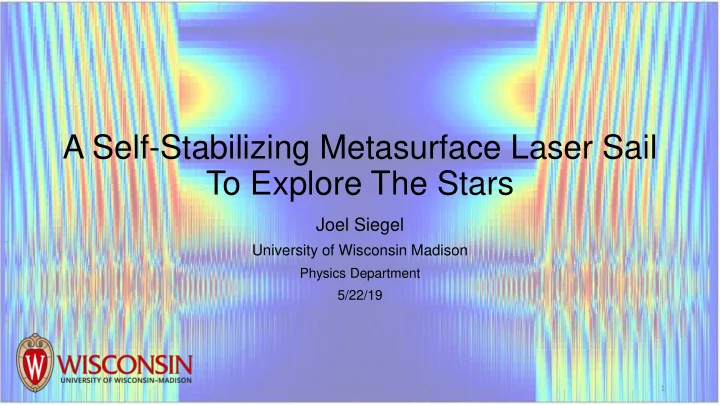

A Self-Stabilizing Metasurface Laser Sail To Explore The Stars Joel Siegel University of Wisconsin Madison Physics Department 5/22/19 1
Laser Propelled Spacecraft Laser Sail High-Power Laser ~10 g, ~100 GW 4x4 m 2 Goal is to travel to Traveling at Alpha Centauri 1/5 th speed (~5 light years away) of light But how do we keep the sail in the beam? Starshot Breakthrough Initiative 2
How fast is 1/5 th the speed of light? • Took the first close up pictures of Pluto in 2015 • One of the fastest man made objects 747 SR-71 Blackbird New Horizons (550mph) (2,700 mph) (36,000 mph) 65xNew Horizons New Horizons (36,000mph) (177,000 mph) (2,365,000 mph) 65xNew Horizons 65xNew Horizons Laser Sail 3 (11,570,000 mph / (152,000,000 mph / Gif from Clay Bavor (2,365,000mph) 0.017c) 0.2c)
Optical Forces 𝑸 𝒋 𝑸 𝒋 Force is determined by the reflected/refracted light 𝝔 𝑺 𝑺 If we control how the light reflects/refracts, we can Force Force control the optical forces Laser Sail 4
Metasurface Based Laser Sail • Thin, lightweight structure with subwavelength scattering elements • Controls the phase and magnitude of reflected/refracted light Reflective Metasurface Focusing Lens Optical Vortex Beam Creation n ~ μ m ~cm Prism Beam Steering Metasurface Beam Steering Y. Yang, et. al. Nanoletters 14, 1394 (2014). Arbitrary wave-fronts can be generated with a metasurface 5 D. Fattal, et. al., Nature Photonics 4, 466 (2010).
Metasurface Example 1 Intensity Gaussian Beam 0 Forces Example Metasurface 6
Metasurface Motion Gaussian Beam Motion can be described by: Dynamic Force 𝑛 𝜖 2 𝜀 Metasurface flies 𝜖𝑢 2 = 𝐷 1 𝜀 + 𝐷 2 𝜄 Coefficients Moves back, but away also rotates 𝐽 𝜖 2 𝜄 Each metasurface/beam 𝜖𝑢 2 = 𝐷 3 𝜀 + 𝐷 4 𝜄 Offset the combination has Metasurface different coefficients Rotation Offset How can we control these coefficients to make a Example Metasurface metasurface that is stable? 7
Designing a Stable Sail Noise Applied to Beam Find a set of stable Create idealized sail to Simulate that sail using parameters generate those coefficients realistic components Sail to simulate 𝑛 𝜖 2 𝜀 with realistic 𝜖𝑢 2 = 𝑫 𝟐 𝜀 + 𝑫 𝟑 𝜄 components Failure Rate 𝐽 𝜖 2 𝜄 𝜖𝑢 2 = 𝑫 𝟒 𝜀 + 𝑫 𝟓 𝜄 1 Million CPU hours • • Requires many (>1 Million) computations with slight parameter variations Requires 1 large computation to produce this plot • • Human intuition for the sail designs Sail design chose from previous stage Over 1 million output files! • • Computation Requirements Computation Requirements Needed HPC Had to write a shell script to • • 1 CPU 80 CPUs to run – which “cat” them all together in • • introduced 1MB of RAM 500 GB of RAM pieces me to HTC • • 3 GB of Disk 5 GB of Disk 8 • • Output of single file is ~10 bytes (0/1 for success/failure and an ID) Output is ~5 GB
Idealized Metasurface to Generate Stable Coefficients Two Offset Gaussians Inverted Cat Eye (ICE) Metasurface Partially Highly Reflective, Transmissive, Parabolic Normal Metasurface 9
Full-Wave Simulation Steering the Beam Reflected Beam front Simulated ICE Metasurface Resonators Partially Transmissive, Transmitted Beam front Parabolic Highly Reflective, Normal 504 μ m, 420 Resonators 10
Local Optical Forces on Metasurface Forces calculated at Overall good agreement each point on sail Full-Wave Sail is Stable! Full-Wave Full-Wave Full-Wave Full-Wave Ideal Ideal No Offset No Offset Offset Ideal Ideal Offset 11
What’s next? • Incorporate optimization techniques that can take advantage of throughput computing to more efficiently explore the parameter space • Generate a sail based on a set of dynamic force coefficients without human intuition • Improve the efficiency of our realistic Figure courtesy of Greg Holdman sails by using optimization based metastructures 3
Acknowledgments • Big Thank You to Christina Koch and Lauren Michael for helping me learn to use CHTC Brar Group Collaborators Mikhail A. Kats – UW Madison Sergey Menabde – KAIST Min Seok Jang – KAIST 13
14
Recommend
More recommend